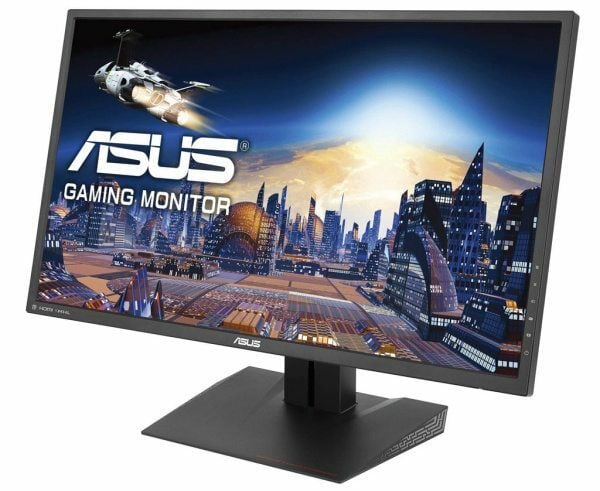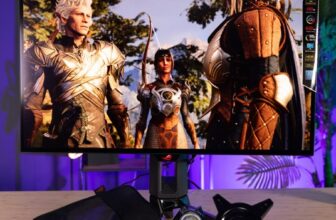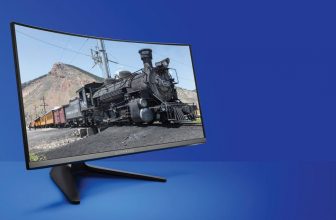ASUS MG279Q Review

The Monitor Your Eyes Want Is The Monitor They Deserve. Read our ASUS MG279Q Review.
Ever been at a friend’s house or a LAN party and glimpsed a computer monitor so beautiful that you felt pangs of jealousy wash over you, to the point where you actually checked your arm to make sure you weren’t turning green? A bright, crisp monitor with excellent color reproduction is something that you can easily take for granted until you come face to face with one. But once you’ve basked in the glory of a really, really good monitor, you may as well know that it will haunt your dreams until you give in and bring one home. (This is sometimes referred to as the “The grass is always greener, until it isn’t” postulate, and it is totally not made-up science.)
[sc name=”ad 2″]

[sc name=”Youtube”]
Once you decide it’s time to get yourself a good monitor, there are lots of options to peruse and lots of data to sift through in order to make the right decision, but we suggest that you save yourself the hassle and end your search here and now. The ASUS MG279Q is a gorgeous 27-inch, WQHD 2,560 x 1,440 monitor that is designed specifically for gaming, and it has the design and the technology to provide the experience you are after.“The MG279Q combines the best gaming features of both TN and IPS panel technology and then some,” says ASUS Product Marketing Specialist David Chiang. “You’re looking at a monitor that combines the vibrant colors and image fidelity that gamers want for immersive environments and the ultrahigh refresh rate needed for nearly uninterruptible visuals.”IPS panel technology. IPS stands for in-plane switching, and it’s a technology that was designed to solve problems with older TN (twisted nematic field effect) displays that had great, fast refresh rates but suffered from poor color reproduction and very narrow viewing angles. (Users essentially had to look at them from directly in front or picture quality degraded badly.)“For gamers who enjoy immersive games like The Witcher 3 or have dozens of graphical enhancement mods in Skyrim, IPS delivers the best possible visual experience,” Chiang says. “The tradeoff is that IPS panels were historically limited to a 60Hz refresh rate.”We’ve talked about the importance of higher refresh rates on many occasions in CPU, but Chiang offers a brief refresher: “In short, frequency dictates maximum frame rate,” he says. “High frame rates are sought after by competitive gamers especially in FPSes and MOBAs simply because at 144Hz, the translation of control to screen is extremely fluid, allowing for increased accuracy and precision.
Traditionally, this is a big reason why gamers have picked TN-panel monitors. There really isn’t any benefit to seeing a “120” in the corner of your monitor from FRAPS if you know the hardware is limited to 60Hz.”Chiang didn’t throw out that 144Hz figure coincidentally. He mentioned it because that’s the MG279Q’s refresh rate, and it’s part of what he was referring to when he said that the monitor combines the best aspects of TN and IPS technology. The other part is the MG279Q’s 100,000,000:1 contrast ratio and its 178-degree viewing angle. At 144Hz, games with lots of stuff moving quickly across the screen (most of them, in other words) look better because they don’t create motion blur. This is aided by the fact that the MG279Q has an impressive 4ms response time. And its 178-degree viewing angle means that if you want to show someone what’s going on in your game, they’ll be able to see it clearly without moving into BESTIES SELFIE range. In fact, with a viewing angle this wide, you can easily show off your jaw-dropping monitor to a whole crowd of admirers.You’ve been hearing a lot about AMD FreeSync technology lately, and with good reason. Although FreeSync isn’t the first technology designed to help graphics cards and monitors play nice, it’s definitely one of the most effective.“Graphics cards churn out variable FPS (frames per second) rates, depending on what’s being rendered on the screen,” Chiang says. “Basically, the more complex the sequence, the lower the FPS will be. Monitors, on the other hand, historically operate at a fixed refresh rate. When a frame takes longer to render, the monitor may already be in the next frame, which means you’re seeing parts of two different frames on the monitor simultaneously.”This is called screen tearing, and it’s not your friend. Your eyes are very good at capturing the images in visual range, even when they are moving extremely quickly, and significant screen tearing is at best a mild distraction. At worst it can be a deal-breaker, especially in games where immersion in the game’s environment is crucial to your enjoyment of the experience.“This problem was originally mitigated by VSync, a software solution that caps the FPS generated by the graphics card to synchronize it with the monitor’s refresh rate,” Chiang says. “The problem with VSync is that it will cause stuttering when FPS generated starts falling below the cap. FreeSync, or adaptive sync, utilizes DisplayPort 1.2a to allow the monitor to communicate directly with the graphics card, syncing what’s on the monitor with the FPS of the graphics card, thus eliminating stuttering and screen tearing.”Because FreeSync doesn’t cap the graphics card’s frame rate, there is no performance penalty tradeoff for eliminating tearing and the like. And although the technology was developed by AMD, the company allows anyone to use it royalty-free; this has led to its adoption by VESA (the Video Electronics Standards Association) as part of the DisplayPort 1.2a specification.For the moment, though, only AMD GPUs and a select group of monitors work together to implement FreeSync, and the ASUS MG279Q is one of those monitors.ASUS has been building hardware for PC gamers for a very long time, and rumor has it that a few of the people on their product teams are known to play the odd PC game themselves now and again. As a result, the MG279Q has a couple more software add-ons that you may find useful and fun. ASUS calls one of them “GamePlus” technology.“The GamePlus hotkey system essentially allows users to add enhancements to their games without having to use software and without having to traverse deep into the OSD,” says Chiang. “Gamers can choose to add timers to their screen for MMO raids or other timed games. Alternatively, gamers can also choose to add a crosshair overlay on the screen, perfect for those ‘training’ to noscope like a pro.”Another MG279Q feature that gamers will appreciate is ASUS’ GameVisual technology. GameVisual lets you access up to six preset display modes that can improve your visual experience and help you be more competitive in various situations or types of games. The GameVisual FPS mode, for instance, cranks up your monitor’s contrast settings so that you can more easily make out your enemies, especially in scenarios and in certain games that tend to be dark. The RTS/RPG setting boosts color saturation and sharpens contrast so that you can more easily make out distinct unit types, even when there are lots of units onscreen at once. There are also Racing (reduces input lag), Cinema (enhanced contrast and color saturation), Scenery (boosts brightness settings and tweaks colors common in scenery photos and film), and sRGB (settings optimized for viewing photos) settings.Finally, ASUS added a feature designed to lend a helping hand to those of us who tend to play for large chunks of time without taking the breaks we probably should; it’s called ASUS Ultra Low Blue Light. This feature uses five settings with varying filters to protect you from harmful blue light in different usage scenarios.“The Ultra Low Blue Light feature is part of the ASUS Exclusive EyeCare solution, with functions designed to make even marathon gaming sessions comfortable to the eye,” Chiang says. “The beauty of the ASUS EyeCare solution is that it only removes the stress inducing frequencies in the blue light spectrum, meaning the picture stays intact. EyeCare also utilizes DC instead of PWM for brightness control, removing the nearly imperceptible flickering, further removing eye stress over time.”As handy as all of the MG279Q’s software features are, the physical design of the monitor may be even more impressive; the monitor is designed to give you an incredible range of configuration options, and to make using it as convenient as possible. For starters, the monitor comes with a wealth of connectivity options and a simple yet highly effective built-in cable management system.The monitor’s Mini DisplayPort 1.2 port provides native WQHD output, and you also get a pair of HDMI ports that are also MHL-enabled, meaning that you can connect smartphones, tablets, and other portable devices to the monitor should the mood strike you or the need arise. The MG279Q also sports a pair of USB 3.0 ports in case you find a need for or can benefit from pass-through USB connectivity.The cable management system is deceptively simple in appearance, but handles an important task: “Let’s be frank,” Chiang says. “No one likes cable spaghetti taking up room on their desk. The smart cable management feature is part of ASUS’ continued philosophy of building products from the consumer’s viewpoint. Simply bundle cables from your computer, monitor, keyboard, and mouse into the cable channel and now you’ve got just one big cable to deal with. Personally, I prefer to add cable ties along the length to ensure it stays neat all the way to the PC.”ASUS knows that every gaming area is just a little different, so the company designed the MG279Q to be highly flexible. Want a multi-monitor setup? Hey, you’re not the only one, so ASUS gave the display an extremely narrow bezel, so that if you plunk three of them down on your desk end to end, there will be only the slightest interruption in your picture moving from one side to the other.In addition, the monitor’s cleverly designed stand tilts vertically (+20 degrees to -5 degrees), swive l s horizontally (+60 degrees to -60 degrees), and pivots (up to 90 degrees clockwise for portrait orientation), and you can adjust its height from 0 to 150mm. In other words, there’s almost nowhere you can put this monitor and not still have a good, comfortable view of it, and that’s good news for folks whose gaming setups are packed in little sub-staircase nooks or who have nonstandard desks and/or chairs.“As with ASUS EyeCare, the MG279Q’s ergonomics are designed for comfort, as angle and distance from the user significantly affects eye stress,” Chiang says. “As the MG279Q is engineered to accommodate multi-monitor setups with its thin bezel design, having these adjustments really allows the MG279Q to fit into an existing or new setup without any trouble.”If you somehow manage to defy the odds and discover that you really can’t find a way to situate the MG279Q on its stand that works for you, you can lose the stand and mount the display on your wall using its VESA mount.It’s easy to toss the cheapest monitor you can find at your desired screen size into your shopping cart, almost as an afterthought, when you are reeling from the sticker-shock of buying the parts for a new build. But when you consider how many hours you will spend staring at your monitor — and let’s face it, your monitor is the primary way in which your PC interacts with you—is that really your best option?
The ASUS MG279Q isn’t the cheapest 27-inch monitor you’ll find on the shelf at your local parts store or your favorite online retailer. But did you buy the cheapest graphics card you could possibly find? The cheapest power supply?
First and foremost, the MG279Q is a great monitor from a visual standpoint, but when you add up its cutting-edge features, FreeSync support, flexible setup options, and its three year warranty, ASUS is betting that you’ll find you can’t afford to settle for anything less.





